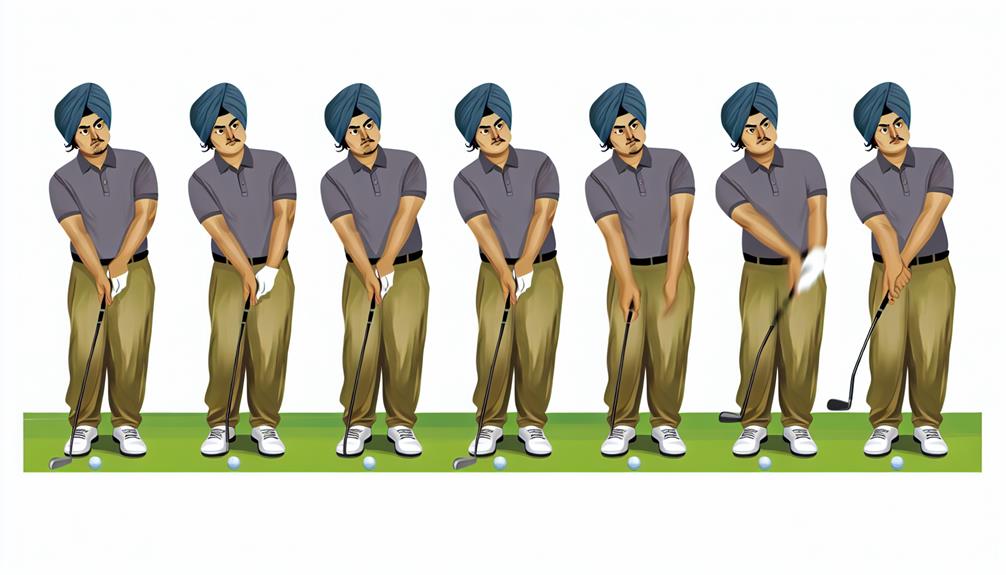Just as a musician perfects a symphony through countless rehearsals, you, as a golfer, refine your putting skills with regular practice. This rhythm of repetition is a key instrument in your golf kit. It's not merely about swinging the club and hoping for the best; it's about understanding the fine points of your swing, the balance of your stance, the grip of your club, and the path your ball takes.
But why does practice make such a significant difference? The answer lies in the intricate dance of brain, body, and behavior, the dance that transforms the ordinary into the extraordinary. Let's explore this fascinating dynamic further.
Understanding the Importance of Practice
You might've heard the saying 'practice makes perfect,' and in the realm of golf putting, this adage holds exceptionally true. This isn't just an empty phrase. It's a principle based on the concept of skill mastery.
To master putting, you can't merely rely on natural talent or occasional play. It requires consistent, focused practice.
Now, when it comes to practice, motivation is key. Without it, you'll find it hard to maintain the discipline needed for regular practice. So, how do you fuel your practice motivation?
Firstly, set achievable goals. Whether it's reducing three-putts or improving your distance control, having a clear objective can make practice feel more rewarding.
Secondly, monitor your progress. Nothing boosts motivation like seeing improvement. Use drills and exercises that offer immediate feedback, so you can track your progression.
How Practice Improves Putting Accuracy
Building on the foundation of regular practice, let's analyze how this discipline directly sharpens your putting accuracy.
At the heart of this improvement is mental focus. When you're on the green, your mind is a powerful tool. Regular practice hones this tool, allowing you to visualize the shot, understand the green's slope and texture, and anticipate the ball's movement. This heightened awareness and mental clarity significantly boost your accuracy over time.
Your equipment selection is another crucial factor improving with practice. By using the same putter repeatedly, you're able to understand its weight, balance, and how it interacts with the ball. Consistency with your equipment allows for greater predictability and control, resulting in more accurate shots.
Moreover, it's through practice that your physical mechanics evolve. Incremental adjustments in your stance, grip, and swing contribute to significant improvements in your putting accuracy. With each repetition, your body learns and remembers the correct alignment, power, and follow-through needed for the perfect putt.
In essence, regular practice cultivates mental focus, refines equipment understanding, and polishes physical mechanics, all of which are critical in elevating your putting accuracy.
The Role of Consistency in Golf Putting
In the realm of golf putting, consistency serves as a linchpin for success, underpinning every stroke you make on the green. It's not just about strength or accuracy; it's about repeating the same successful action over and over again. This is where your mental focus comes into play.
Your mind must be laser-focused on the task at hand, and this requires practice. You can't simply step onto the green and expect to sink every putt. You need to practice your putting routines regularly to develop a smooth, reliable stroke that you can count on when the pressure is on.
Consistency in golf putting also extends to your pre-shot routines. You've got to have a set routine that you follow before every putt. This might include lining up your shot, taking a few practice swings, or visualising the ball's path into the hole. By following this routine every time, you'll build consistency and confidence, which can significantly improve your putting performance.
In essence, consistency is the thread that holds your golf putting game together. It's the result of regular practice, mental focus, and a solid putting routine. Without it, even the most technically perfect stroke can unravel under pressure.
Training Techniques for Better Putting
Mastering a few key training techniques can dramatically improve your golf putting prowess, turning a shaky performance on the green into a string of successful putts.
Let's start with Putter Selection. The right putter can make or break your game. Experiment with different lengths, weights, and designs until you find one that feels natural in your hands and aligns well with your putting stance.
Next, consider Mental Conditioning. Golf is as much a mental game as it's a physical one. You need to train your mind to stay focused and calm under pressure. Visualization techniques, for instance, can be an effective tool. Picture the ball following the exact path you want it to take into the hole.
Measuring Improvement in Your Golf Putting
Gauging your progress in golf putting is crucial, as even a small improvement can drastically transform your overall game performance. It's not just about sinking more putts, but how you achieve this outcome.
Two key areas to evaluate are your putter selection and mental focus.
Putter selection isn't just about choosing the most expensive or popular putter on the market. It's about finding the one that feels right in your hands and aligns with your putting style. You'll know you've made the right choice when your strokes become more consistent and confident.
Mental focus is often overlooked, yet it's vital in enhancing your putting skills. It's about maintaining concentration, visualizing the path of the ball, and managing your emotions. A lapse in focus can lead to misjudgments in speed and direction, while a steady mind can deliver a smooth and accurate putt.
To measure improvement, track the number of putts per round and the distance from which you're consistently successful. Observe changes in your confidence level and the consistency of your stroke. Improvement isn't just about numbers, but also about the quality of your performance and your growth as a golfer.

